Tsushima. Accuracy Factors of Japanese Artillery
Introduction
At the very beginning of the twentieth century, there was an intensive development of naval artillery: new powerful and long-range guns appeared, shells were improved, rangefinders and optical sights were introduced. In total, this made it possible to fire at previously unattainable distances, significantly exceeding the range of a direct shot. At the same time, the issue of organizing long-range shooting was very acute. The maritime powers have tackled this challenge in many ways.
By the beginning of the war with Russia, the Japanese fleet already had its own method of fire control. However, the battles of 1904 demonstrated its imperfection. And the technique was significantly redesigned under the influence of the received combat experience. Elements of centralized fire control were introduced to Tsushima on ships.
In this article, we will consider both the technical and organizational aspects of the management of Japanese artillery in the Battle of Tsushima. We will conduct our acquaintance exactly according to the same plan as in the previous one. article about the Russian squadron:
• rangefinders;
• optical sights;
• means of transferring information to tools;
• shells;
• organizational structure of artillery;
• method of fire control;
• target selection;
• training for gunners.
Rangefinders
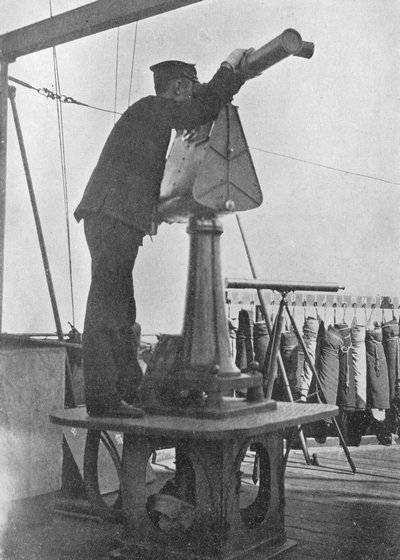
Rangefinder determines the distance
By the beginning of the war, on all large Japanese ships, two rangefinders (on the bow and stern bridge) manufactured by Barr & Stroud, model FA2, were installed to determine the distance. But by this time, the production of a new model FA3 had already begun, which, according to the passport, had twice the accuracy. And at the beginning of 1904, Japan purchased 100 of these rangefinders.
Thus, in the Battle of Tsushima, all Japanese ships of the battle line had at least two Barr & Stroud FA3 rangefinders, similar to those installed on the Russian ships of the 2nd Pacific Squadron.
Rangefinders played a rather modest role in combat. There were no complaints about their work.
Optical sights
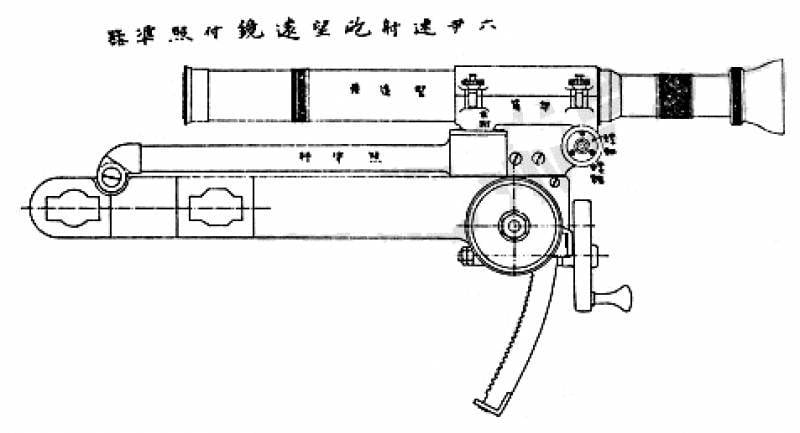
Optical sight on the 6 "bar of the Armstrong gun
All Japanese guns, starting with the 12-pounder (3 ”), had two sights: a mechanical H-shaped and an 8-fold optical sight produced by Ross Optical Co.
Optical sights made it possible in the Tsushima battle, already from a distance of 4 m, to direct shells to a certain part of the ship, for example, to the tower. During the battle, the fragments repeatedly disabled the optical sights, but the gunners promptly replaced them with new ones.
Long-term observation through the lenses led to eye fatigue and impaired vision, so the Japanese even planned to attract fresh gunners from the other side's guns to replace them. However, in Tsushima, this practice was not resorted to due to the fact that there were breaks in the battle, and the ships changed the firing side several times.
Means of information transmission
In the Battle of Tsushima, different means were used, duplicating each other, to transmit commands and data for pointing guns on different ships:
• electromechanical indicator;
• negotiation pipe;
• telephone;
• clock face;
• mouthpiece;
• plate.
Consider them in more detail.
Electromechanical pointer
The Japanese ships were equipped with electromechanical devices "Barr & Stroud", which transmitted distance and commands from the conning tower to artillery officers. In design and principle of operation, they were similar to the Geisler instruments on Russian ships.
On the one hand, these pointers did not suffer from noise and clearly conveyed information, and on the other hand, the subtle movements of the arrows under conditions of shaking from shots could escape the attention of the receiving side. Therefore, the transmission of distance and commands was always duplicated in other ways.
Negotiation pipe
The negotiation pipes connected the key posts of the ship: the conning tower, aft wheelhouse, towers, casemate guns, tops, the upper bridge, etc. They were very convenient for communication in peacetime, but during the battle it was difficult to use them due to the constant noise and rumble.
Nevertheless, in Tsushima, negotiating pipes were actively used to transmit commands, and in those cases when they failed due to damage, they used messenger sailors with signs.
Phone
A telephone was used to transmit commands. He conveyed the voice with sufficient quality. And with strong battle noise, it provided better audibility than voice trumpets.
Clock face
The dial was located on the bow bridge and served to transmit the distance to the casemates. It was a round disc about 1,5 meters in diameter with two hands, reminiscent of a clock, but with ten, not twelve, divisions. A short red arrow stood for thousands of meters, a long white arrow for hundreds of meters.
Bullhorn
The horn was actively used to transmit orders and firing parameters from the cabin to the messenger sailors. They wrote down information on a board and passed it on to the gunners.
In battle conditions, the use of the horn was very difficult due to the noise.
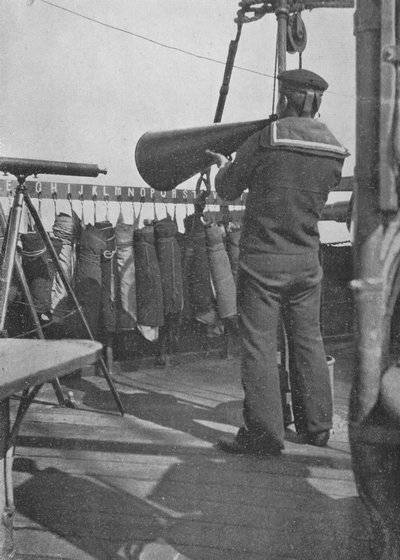
Voice command transmission
Nameplate
A small black board with chalk notes, which was betrayed by a messenger sailor, was the most effective means of communication in the face of strong rumbles and shocks from his own shots. No other method has provided comparable reliability and visibility.
Due to the fact that the Japanese in the Battle of Tsushima used several different methods in parallel to transmit information, a clear and continuous communication was ensured for all participants in the centralized fire control process.
Shells
The Japanese fleet in the Tsushima battle used two types of ammunition: high-explosive and armor-piercing No. 2. They all had the same weight, the same inertial fuse and the same equipment - shimozu. They differed only in that the armor-piercing shells were shorter, had thicker walls and less weight of explosives.
In the absence of any strict regulations, the choice of the type of ammunition was decided on each ship independently. In fact, high-explosive shells were used much more often than armor-piercing shells. Some ships generally only used landmines.
The Japanese land mines were very sensitive. When they touched the water, they raised a tall column of spray, and when they hit the target, they produced a bright flash and a cloud of black smoke. That is, in any case, the fall of the shells was very noticeable, which greatly facilitated zeroing and adjustment.
Armor-piercing shells did not always explode when hitting the water, so the Japanese practiced combining ammunition in a volley: one barrel fired armor-piercing, and the other high-explosive. At long distances, armor-piercing shells were not used.
Artillery organizational structure
The artillery of the Japanese ship was organizationally divided into two groups of main-caliber guns (bow and stern turrets) and four groups of medium-caliber guns (bow and stern on each side). At the head of the groups were officers: one was assigned to each turret of the main caliber and two more led the bow and stern groups of medium caliber (it was believed that the battle would not be fought on both sides at the same time). The officers were usually in towers or casemates.
The main method of firing was centralized fire, in which the firing parameters: target, range, correction (base, for 6 "guns) and the moment of firing were determined by the firing manager (senior artillery officer or ship captain), who was on the upper bridge or in the conning tower. The group commanders had to participate in the transmission of the shooting parameters and monitor the accuracy of their execution. They were supposed to take over the functions of fire control only when switching to rapid fire (in Tsushima this happened rarely and by no means on all ships). The functions of the commanders of the main caliber turrets, in addition, included recalculating the corrections for their guns based on the data obtained for the medium caliber.
Before Tsushima, the organizational structure of the Japanese artillery was about the same. The key differences were that the commander of each group independently controlled the fire: he specified the distance, calculated the corrections, and even chose the target. For example, in the battle of August 1, 1904 in the Korean Strait, Azuma at one of the moments simultaneously fired at three different targets: from the bow tower - “Russia”, from 6 “guns -“ Thunderbolt ”, from the aft tower -“ Rurik ”.
Fire control technique
The Japanese fire control technique used at Tsushima was quite different from that used in previous battles.
First, let's take a quick look at the “old” technique.
The distance was determined using a rangefinder and transmitted to an artillery officer. He calculated the data for the first shot and transmitted them to the guns. After the sighting began, fire control passed directly to the gun group commanders, who observed the results of their firing and independently made adjustments to them. The fire was conducted in volleys or at the readiness of each gun.
This technique revealed the following disadvantages:
• The commanders of the groups from the not high enough towers and wheelhouses did not see the fall of their shells at a long distance.
• During independent shooting, it was not possible to distinguish between our own bursts from those of others.
• Gunners often independently adjusted the parameters of fire, making it difficult for officers to control fire.
• With the existing difficulties with the correction due to the inability to distinguish between the fall of the projectiles, the final accuracy was unsatisfactory.
An effective solution in the battle on July 28, 1904 in the Yellow Sea was proposed by the senior artillery officer of the Mikasa K. Kato, adding the following improvements to the salvo firing:
• Fire all guns on only one target.
• Strict adherence to uniform (within the same caliber) shooting parameters.
• Observation of the fall of shells from fore-mars.
• Centralized adjustment of shooting parameters based on the results of previous shots.
This is how centralized fire control was born.
In preparation for the Battle of Tsushima, the Mikasa's positive experience was extended to the entire Japanese fleet. Admiral H. Togo explained the fleet transition to a new technique:
The centralized fire control process used by the Japanese in the Battle of Tsushima consisted of the following stages:
1. Measurement of distance.
2. Initial calculation of the amendment.
3. Transfer of shooting parameters.
4. Shot.
5. Observation of the shooting results.
6. Correction of shooting parameters based on observation results.
Further, the transition to stage 3 and their cyclic repetition from the 3rd to the 6th.
Distance measurement
The range finder from the upper bridge determined the distance to the target and transmitted it to the fire control through the negotiating pipe (if he was in the conning tower). H. Togo, before the battle, recommended refraining from shooting at more than 7 meters, and he planned to start the battle from 000 meters.
Except for the first sighting shot, the readings of the rangefinder were no longer used.
Initial calculation of the amendment
The fire controller, based on the readings of the rangefinder, taking into account the relative movement of the target, the direction and speed of the wind, predicted the range at the time of the shot and calculated the value of the rear sight correction. This calculation was carried out only for the first sighting shot.
Passing firing parameters
In parallel, the fire controller transmitted firing parameters to the guns in several ways: range and correction. Moreover, for 6 "guns it was a ready-made amendment, and the commanders of the main caliber guns were required to recalculate the received amendment according to the data of a special table.
The gunners were strictly instructed not to deviate from the range received from the fire control. It was allowed to change the rear sight amendment only in order to take into account the individual characteristics of a particular weapon.
Shot
Zeroing was usually carried out with 6 ”guns of the bow group. For better visibility in conditions of poor visibility or concentration of fire from several vessels, 3-4 guns fired in a salvo using the same parameters. With a long distance and good observation conditions, the volley could be carried out by a "ladder" with different distance settings for each gun. At a shorter distance, single sighting shots could also be used.
A volley on the defeat was made by all possible barrels of the same caliber.
The commands for the shot were given by the fire controller with the help of an electric howler or voice. On the command "to prepare for a volley", aiming was carried out. At the command "volley" a shot was fired.
Synchronous shooting required great coordination in the work of both loaders and gunners, who had to do their work strictly in the allotted time.
Observation of shooting results
The results of the shooting were monitored by both the shooting manager himself and the officer on the fore-mars, who transmitted information using a horn and flags.
The observation was carried out through telescopes. In order to distinguish the fall of their shells from those of others, two techniques were used.
First, the moment the shells fell was determined using a special stopwatch.
Secondly, they practiced visual accompaniment of the flight of their projectile from the moment of the shot to the very fall.
The hardest part was tracking your projectiles in the final phase of the Tsushima battle. "Mikasa" fired at "Borodino" and "Orel" from a distance of 5800-7200 m. The glare of the setting sun, reflected from the waves, greatly interfered with observation. The senior artillery officer of Mikasa himself could no longer distinguish between the hits of his 12 "shells (from 6" guns they did not fire because of the great distance), so he adjusted the fire only according to the words of the officer on the fore-mars.
Adjustment of shooting parameters based on observation results
The fire controller made corrections for the new salvo based on observation of the results of the previous one. The distance was adjusted based on the ratio of undershoots and overflights. However, he no longer relied on the readings of the rangefinder.
The calculated parameters were transferred to the gunners, a new salvo was fired. And the firing cycle was repeated in a circle.
Completion and resumption of the firing cycle
The fire was interrupted when visibility conditions did not allow observing its results or when the range became too great. However, there were interesting moments in Tsushima when the fire was interrupted not because of the weather or the increase in distance.
So, at 14:41 (hereinafter, the Japanese time), the fire on "Prince Suvorov" was suspended due to the fact that the target disappeared in the smoke from the fires.
At 19:10, Mikasa finished firing due to the impossibility of observing the fall of the shells due to the sun shining in the eyes, although at 19:04 hits were noted at Borodino. Some other Japanese ships continued to fire until 19:30.
After a break, the firing cycle began again with measuring the range.
Rate of fire
Japanese sources mention three rates of fire in the Battle of Tsushima:
• Measured fire.
• Ordinary fire.
• Rapid fire.
Measured fire was usually fired at long distances. Single fire on medium. Rapid fire, according to the instructions, was prohibited at a range of more than 6 m, and was rarely used in battle and by no means all ships.
The available information does not make it possible to unambiguously link the method of fire control and the rate of fire. And we can only assume that with measured and ordinary fire, the shooting was carried out in volleys with centralized control, and with rapid fire - independently, according to the readiness of each weapon and, most likely, according to the "old" method.
Based on the sequence of actions during centralized firing, volleys, even with ordinary fire, could not be very frequent (according to the instructions, no more than 3 rounds per minute for 6 "guns). The observations of the British attaches also confirm the low rate of fire in the Battle of Tsushima.
Target selection
In the Battle of Tsushima, there were no instructions or orders from the admiral to concentrate fire on a specific enemy ship. The fire controller chose the target on his own, first of all paying attention to:
• The closest or most convenient ship for shooting.
• If there is not much difference, then the first or the last ship in the ranks.
• The most dangerous enemy ship (causing the most damage).
Artillery exercises
In the Japanese fleet, a well-developed methodology for training artillerymen was used, in which the main role was assigned to barrel firing from enclosed rifles.
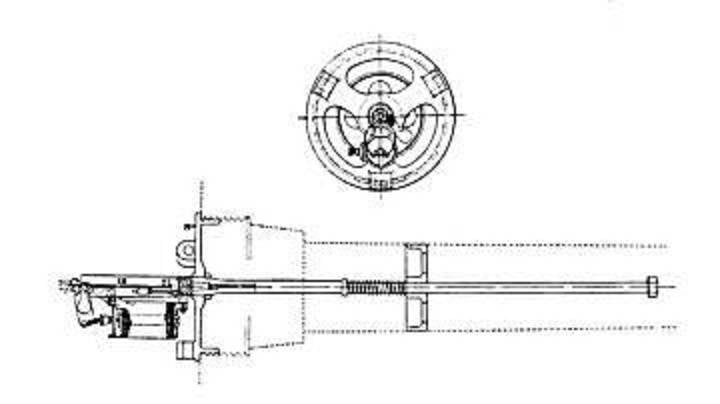
A device for placing a rifle in the barrel of a gun
The target for barrel shooting was a canvas stretched over a wooden frame and placed on a raft.
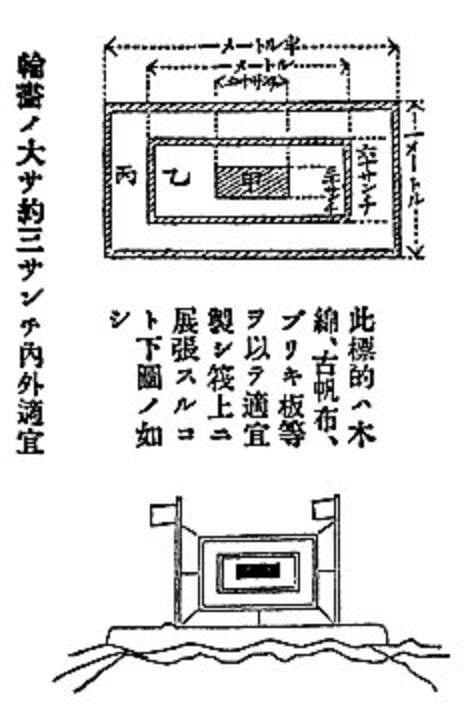
Target for barrel shooting
At the first stage, the gunner simply learned to use the sight and aim the gun at the target without firing a shot.
For training in aiming at a moving target, a special simulator (dotter) was also used. It consisted of a frame, inside which a target was located, displaced both in the vertical and horizontal directions. The gunner had to "catch" her in the sight and press the trigger, while the result was recorded: hit or missed.
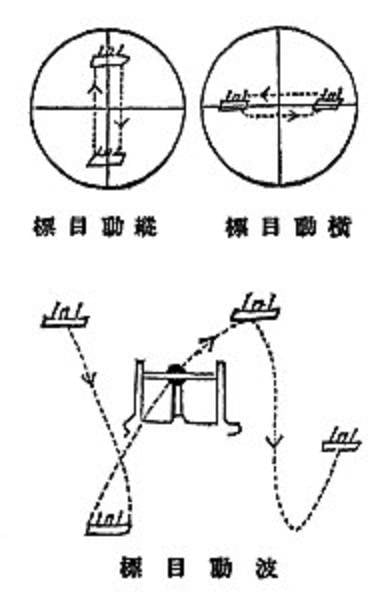
Aiming at the target through the optical sight (top) and mechanical (bottom)
At the second stage, individual barrel firing was carried out at the target from each gun in turn.
At first, the fire was fired from a close distance (100 m) at a stationary target from a moored ship.
Then they moved to a long distance (400 m), where, first of all, they fired at a stationary target, and in the second, at a towed one.
At the third stage, the fire was carried out similarly to the previous exercise, only at the same time from the entire battery, one target at a time.
At the last, fourth stage, the shooting was carried out on the move by the entire ship in conditions as close as possible to combat ones. The target was towed first in the same direction, and then in the opposite direction (on the counter courses) at a distance of up to 600-800 m.
The main parameter for assessing the quality of training was the percentage of hits.
Before the battle of Tsushima, exercises were carried out very often. So, starting in February 1905, "Mikasa", if there were no other events, conducted two barrel firing a day: in the morning and in the afternoon.
To understand the intensity and results of the Mikasa barrel firing for individual days, the data are summarized in the table:
In addition to the gunners, the Japanese also trained loaders, for which a special stand was used, on which the speed and coordination of actions were worked out.
The Japanese navy also fired training rounds with reduced charges from combat guns. The target was usually a small rocky island 30 m long and 12 m high. From the information that has come down to us, it is known that on April 25, 1905, the ships of the 1st combat detachment fired on the move, while the distance to the island was 2290-2740 m.
The shooting results are summarized in a table.
Unfortunately, information about other large practical firing has not reached us. However, based on indirect data on the shooting of the barrels of Japanese guns, it can be assumed that they could not be very frequent and intense.
Thus, barrel shooting played a major role in maintaining and improving the skills of Japanese gunners. At the same time, they trained not only aiming, but also the combat interaction of artillerymen of all levels. The practical experience of zeroing, observing and adjusting was primarily gained in previous battles, and not in exercises.
Also, the very high intensity of the preparation of the Japanese for the general battle should be especially canceled. And the fact that they led it until the very last day, meeting the enemy "at the peak of the form."
Conclusions
In the Tsushima battle, the Japanese shooting method gave excellent results.
At 14:10 (hereinafter, the time is Japanese) from a distance of 6 m "Mikasa" began zeroing in on "Prince Suvorov" with regular volleys from the nasal casemates of the starboard side. At 400:14 from a distance of 11 m "Mikasa" opened fire to kill with the main and medium caliber. Shots soon followed.
From the side of the 1st rank captain Clapier de Colong, who was in the wheelhouse of the Russian flagship, it looked like this:
In the conning tower, through the gaps, fragments of shells, small chips of wood, smoke, splashes of water from undershoots and flights sometimes continuously fall in a whole rain. The noise from the continuous strikes of shells near the conning tower and their own shots drowns out everything. Smoke and flames from the explosions of shells and numerous nearby fires make it impossible to observe through the openings of the wheelhouse what is happening around. Only in fits and starts can you see individual parts of the horizon ...
At 14:40, observers from Mikasa noted that almost every shot of both 12 "and 6" guns hit the "Prince Suvorov", and the smoke from their explosions covered the target.
At 14:11 from a distance of 6 m "Fuji" opened fire on "Oslyaba". Already at 200:14 14 "the projectile hit the bow of the Russian ship. Moreover, this was not the first hit in the "Oslyabya" (the authors of the previous ones could have been other ships).
Warrant officer Shcherbachev observed the picture of the shelling of the flagship of the 2nd detachment from the aft tower of the "Eagle":
The accuracy and, consequently, the effectiveness of the fire of the Japanese artillery in the outset of Tsushima was much higher than in the battle on July 28, 1904 in the Yellow Sea. Already in about half an hour after the start of the battle, the "Prince Suvorov" and "Oslyabya" were out of order with great damage and never returned to it.
How, then, did the Japanese artillery, which on July 28, 1904, in a few hours could neither inflict heavy damage on the Russian battleships, nor even ignite large fires, so quickly achieved results on May 14, 1905?
And why the Russian squadron could not oppose anything to this?
Let's compare the key factors in the accuracy of artillery in the Battle of Tsushima, summarized in the table for clarity.
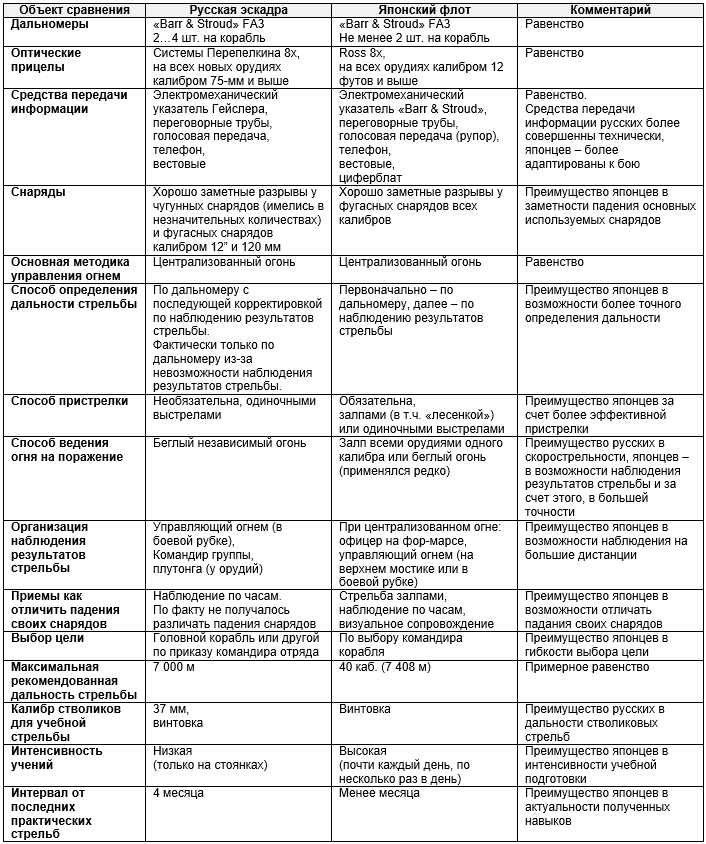
From a comparison of the accuracy factors of artillery, the following conclusions can be drawn.
Both sides had an approximately equal technical base (rangefinders, sights, firing data transmission means).
The Japanese navy used a more sophisticated fire control technique, developed on the basis of accumulated experience. This technique made it possible to distinguish between the falls of their shells and adjust fire on them even when firing several ships at the same target.
The Russian shooting technique did not take into account the experience of previous battles to the proper extent and was not worked out in practice. In fact, it turned out to be "inoperative": any acceptable accuracy could not be achieved due to the fact that it was impossible to adjust the fire based on the results of the shells falling due to the impossibility of distinguishing between them.
The Japanese navy conducted a very intense artillery exercise just prior to the Battle of Tsushima.
The Russian squadron fired only before going out on a campaign and during stops. The last practical exercises took place long before the battle.
Thus, the superiority of the Japanese in the accuracy of firing was achieved primarily through the use of better control techniques and a higher level of training of gunners.
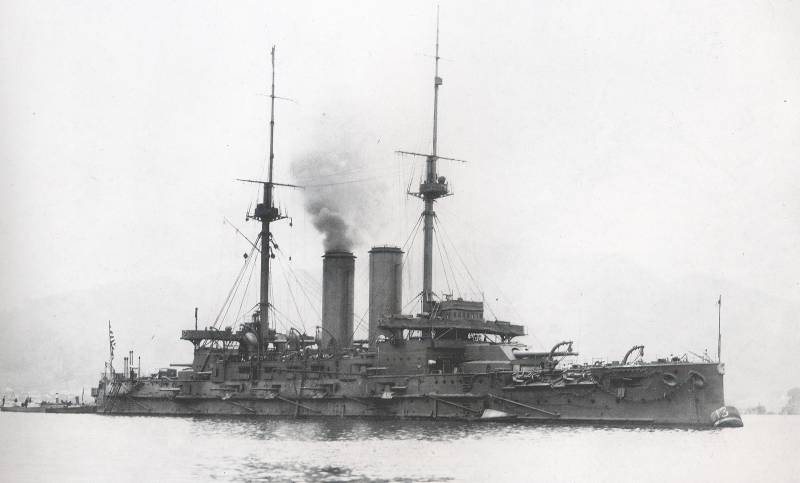
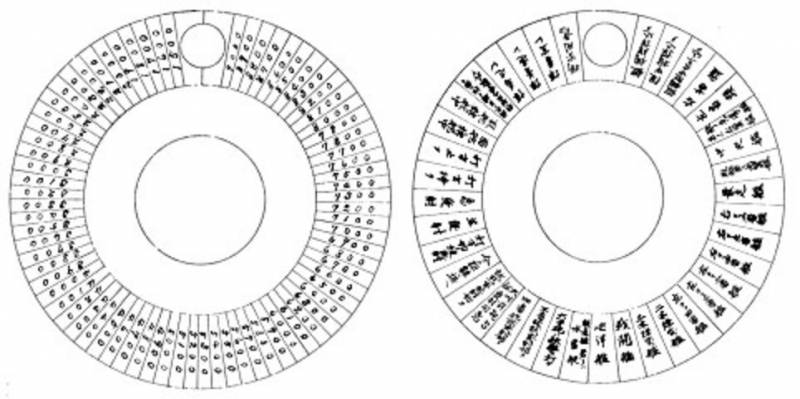
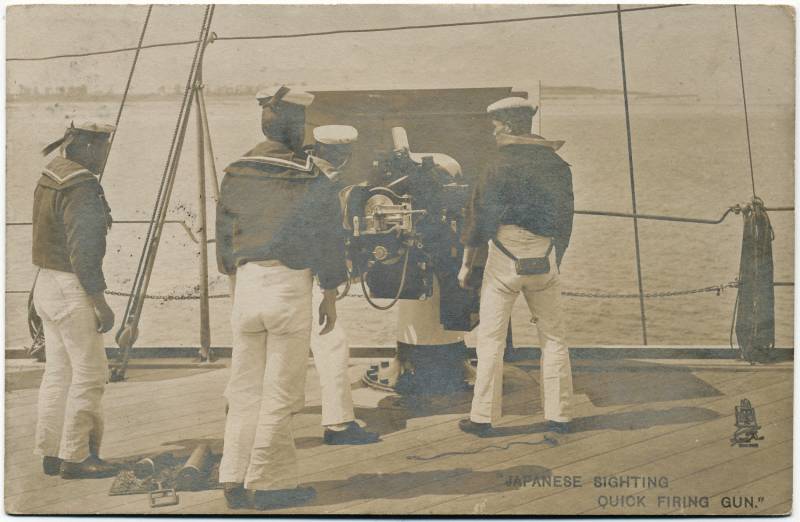
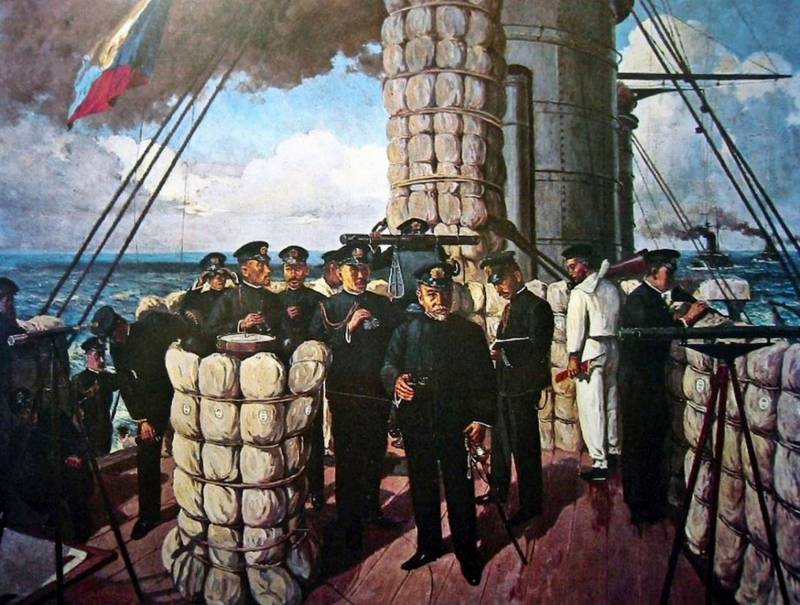
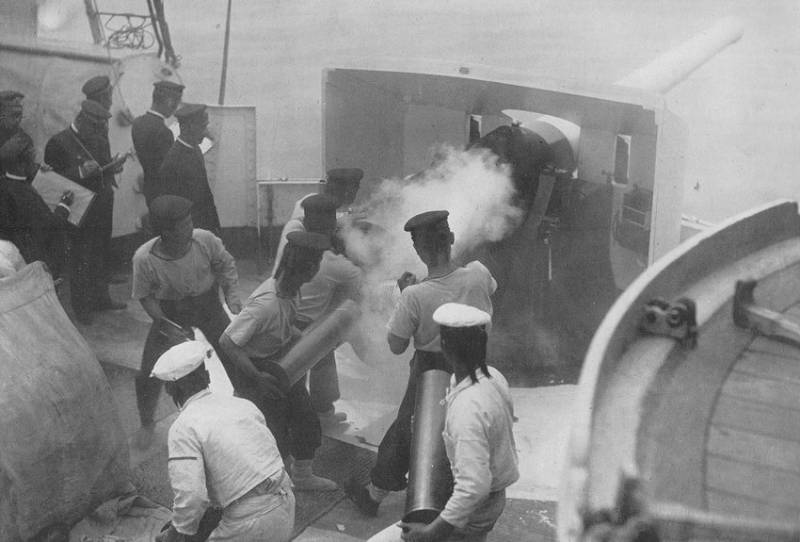
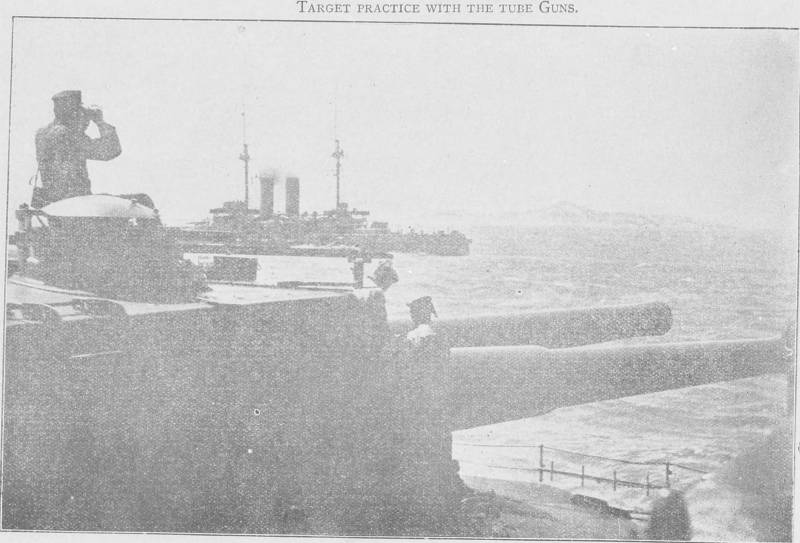

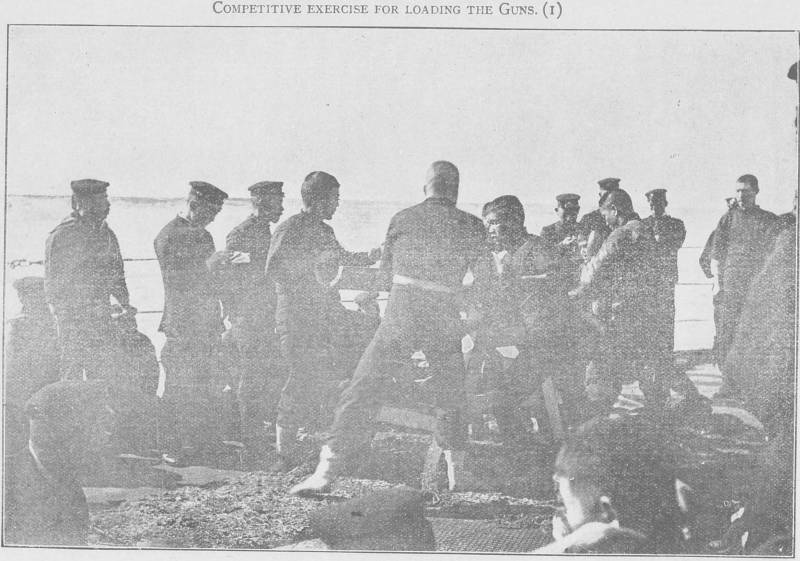

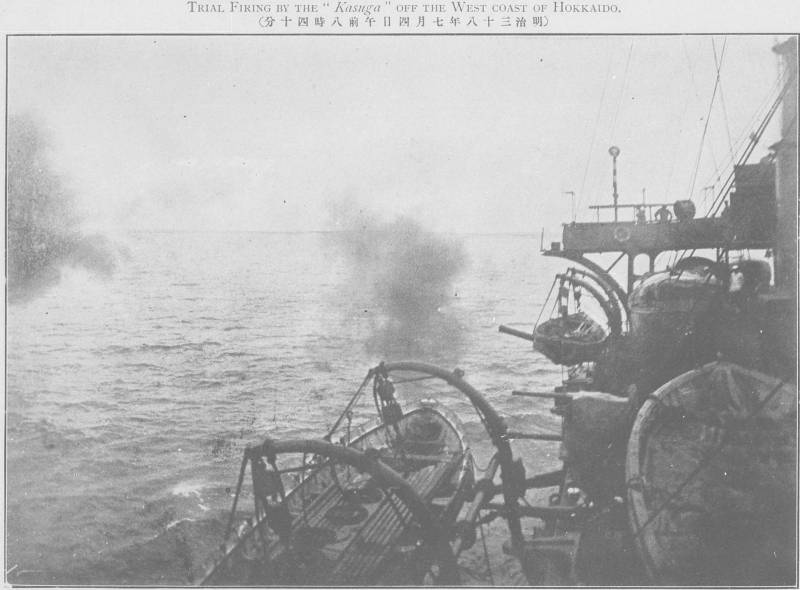
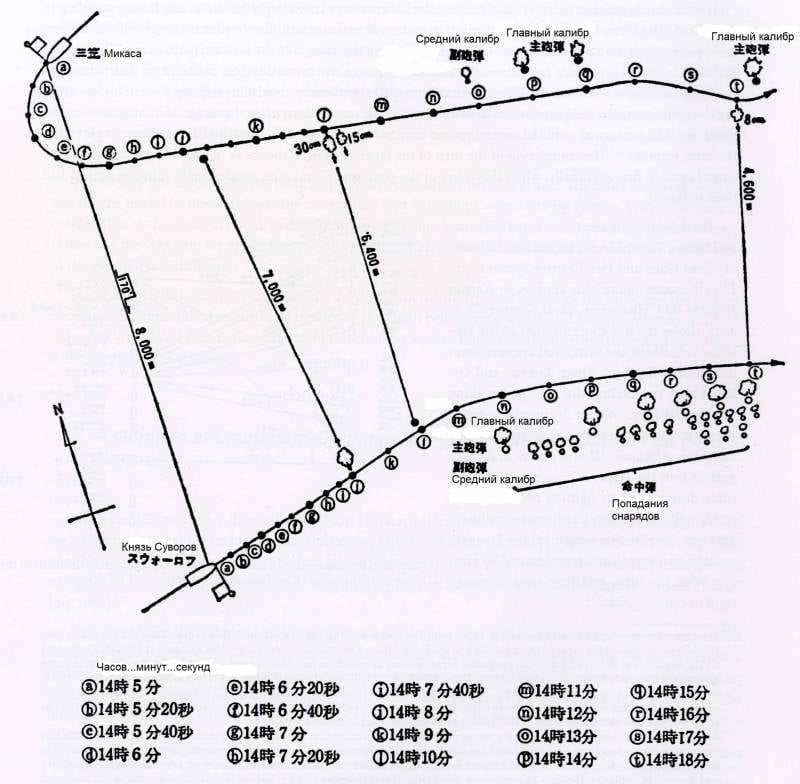
Information